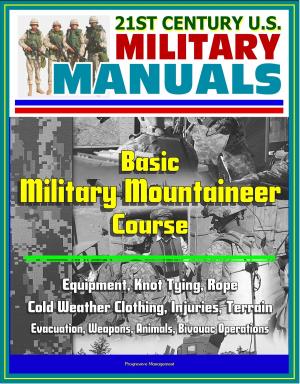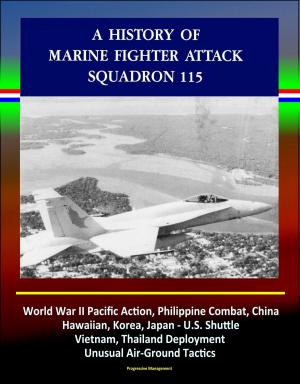Aerial Interdiction: Air Power and the Land Battle in Three American Wars - World War II, Korean War, Vietnam, War in Southeast Asia - Railyard Bombing, Operation Overlord, Pusan, Easter Offensive
Nonfiction, History, Military, Aviation, World War II| Author: | Progressive Management | ISBN: | 9781311386540 |
| Publisher: | Progressive Management | Publication: | June 4, 2015 |
| Imprint: | Smashwords Edition | Language: | English |
| Author: | Progressive Management |
| ISBN: | 9781311386540 |
| Publisher: | Progressive Management |
| Publication: | June 4, 2015 |
| Imprint: | Smashwords Edition |
| Language: | English |
Professionally converted for accurate flowing-text e-book format reproduction, this unique USAF publication explores aerial interdiction—the practice of attacking the unengaged potential of enemy armies—as the U.S. Air Force has employed it in three wars: World War II, the Korean conflict, and the war in Southeast Asia. The purpose of interdiction is to prevent men, equipment, and supplies from reaching a place of combat when the enemy needs them and in the quantities he requires. When an interdictor's attacks upon lines of communication render a hostile army weaker than it would otherwise have been, interdiction has to that degree been successful. When the enemy's offensive or defensive powers remain unimpaired, interdiction has failed. The measure of success for an interdiction campaign, in short, must be its effect on the ground battle. This is the criterion that informs the chapters of this study.
Interdiction campaigns have succeeded through some combination of three methods. The first of these is attrition—the destruction of men and materiel. The second is blockage—the damming up, as it were, of the enemy's lines of communications. The third method is to induce systemic inefficiencies in the enemy's logistical system by forcing him to rely upon circuitous routes or means of transport slower or less capacious than would otherwise have been available to him.
Interdiction was an important mission of the American air arm in each of the three conflicts discussed in this book. Both its success and its failures were at times of considerable importance.
Preface * Introduction * Section I: World War II * Origins of Aerial Interdiction * 1. Northwest Africa, November 1942-May 1943 * 2. The Sicilian Campaign, July-August 1943 * 3. Salerno: The Invasion of Italy, September 1943 * 4. Anzio, January 2-February 19, 1944 * 5. Operation Strangle, March 19-May 10, 1944 * 6. Operation Diadem: Interdiction and the Battle for Rome, May 11-June 10, 1944 * 7. Operation Overlord: The Invasion of Northwestern France March 25-June 30, 1944 * Section II: The Korean War * American Tactical Aviation After World War II * 8. The Pusan Perimeter, August 3-September 23, 1950 * 9. Korean Interdiction Campaigns of 1951 * Section III: The War in Southeast Asia * Massive Retaliation and the Unheeded Lessons of Korea * 10. Operation Commando Hunt VII: Southern Laos, 1971-1972 * 11. The Easter Offensive, March 30-September 16, 1972 * Conclusion
Interdiction, which the Air Force Manual 1-1, Basic Aerospace Doctrine of the (7.5. Air Force, defines as actions "to delay, divert, or destroy an enemy's military potential before it can be brought to bear effectively against friendly forces," is one of the oldest forms of aerial warfare. All the major belligerents in World War I resorted to attacks upon their adversaries' lines of communication almost immediately after the outbreak of hostilities in August 1914. During World War II interdiction contributed importantly to Anglo-American victories in North Africa, Italy, and France. It was markedly less successful in Korea and Southeast Asia, but remains an important mission of the U.S. Air Force. The present work examines eleven representative interdiction campaigns waged by the U.S. Air Force and its predecessor, the U.S. Army Air Forces, during the Second World War, the Korean conflict, and the war in Southeast Asia. One aim has been to provide an accurate, accessible, and reasonably complete account of these campaigns. Another has been to analyze them with a view to determining what tactics and conditions have fostered successful interdiction.
Professionally converted for accurate flowing-text e-book format reproduction, this unique USAF publication explores aerial interdiction—the practice of attacking the unengaged potential of enemy armies—as the U.S. Air Force has employed it in three wars: World War II, the Korean conflict, and the war in Southeast Asia. The purpose of interdiction is to prevent men, equipment, and supplies from reaching a place of combat when the enemy needs them and in the quantities he requires. When an interdictor's attacks upon lines of communication render a hostile army weaker than it would otherwise have been, interdiction has to that degree been successful. When the enemy's offensive or defensive powers remain unimpaired, interdiction has failed. The measure of success for an interdiction campaign, in short, must be its effect on the ground battle. This is the criterion that informs the chapters of this study.
Interdiction campaigns have succeeded through some combination of three methods. The first of these is attrition—the destruction of men and materiel. The second is blockage—the damming up, as it were, of the enemy's lines of communications. The third method is to induce systemic inefficiencies in the enemy's logistical system by forcing him to rely upon circuitous routes or means of transport slower or less capacious than would otherwise have been available to him.
Interdiction was an important mission of the American air arm in each of the three conflicts discussed in this book. Both its success and its failures were at times of considerable importance.
Preface * Introduction * Section I: World War II * Origins of Aerial Interdiction * 1. Northwest Africa, November 1942-May 1943 * 2. The Sicilian Campaign, July-August 1943 * 3. Salerno: The Invasion of Italy, September 1943 * 4. Anzio, January 2-February 19, 1944 * 5. Operation Strangle, March 19-May 10, 1944 * 6. Operation Diadem: Interdiction and the Battle for Rome, May 11-June 10, 1944 * 7. Operation Overlord: The Invasion of Northwestern France March 25-June 30, 1944 * Section II: The Korean War * American Tactical Aviation After World War II * 8. The Pusan Perimeter, August 3-September 23, 1950 * 9. Korean Interdiction Campaigns of 1951 * Section III: The War in Southeast Asia * Massive Retaliation and the Unheeded Lessons of Korea * 10. Operation Commando Hunt VII: Southern Laos, 1971-1972 * 11. The Easter Offensive, March 30-September 16, 1972 * Conclusion
Interdiction, which the Air Force Manual 1-1, Basic Aerospace Doctrine of the (7.5. Air Force, defines as actions "to delay, divert, or destroy an enemy's military potential before it can be brought to bear effectively against friendly forces," is one of the oldest forms of aerial warfare. All the major belligerents in World War I resorted to attacks upon their adversaries' lines of communication almost immediately after the outbreak of hostilities in August 1914. During World War II interdiction contributed importantly to Anglo-American victories in North Africa, Italy, and France. It was markedly less successful in Korea and Southeast Asia, but remains an important mission of the U.S. Air Force. The present work examines eleven representative interdiction campaigns waged by the U.S. Air Force and its predecessor, the U.S. Army Air Forces, during the Second World War, the Korean conflict, and the war in Southeast Asia. One aim has been to provide an accurate, accessible, and reasonably complete account of these campaigns. Another has been to analyze them with a view to determining what tactics and conditions have fostered successful interdiction.















